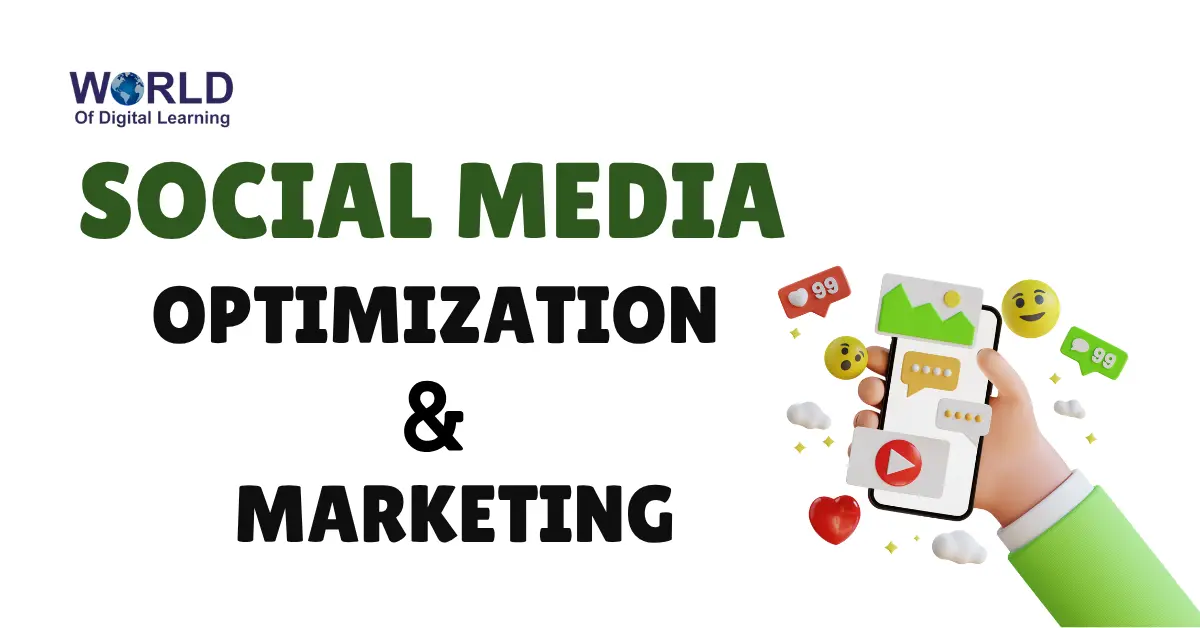Social Media Optimization (SMO) is the process of strategically enhancing a brand’s online presence across social media platforms by optimizing profiles, planning content, encouraging engagement, and maximizing shareability. SMO involves activities such as tailoring content for each platform, using effective hashtags, interacting with users, and analyzing performance to boost visibility and attract loyal followers. The approach builds brand credibility, supports long-term audience growth, and complements other digital strategies like SEO and content marketing.
Social Media Marketing (SMM), in contrast, focuses on actively promoting a brand or its products using both organic posts and paid advertising campaigns. SMM leverages direct tactics such as sponsored ads, influencer partnerships, frequent posting, and targeted outreach to achieve specific results—like driving traffic, generating leads, and increasing conversions. SMM delivers quick, measurable outcomes through precise audience targeting, while SMO forms the backbone for sustained organic engagement and community connections.
Table of Contents
Creating an Attractive Social Media Page
Creating an attractive social media page begins with optimizing your profile for a strong first impression: use a high-quality profile image, write a concise bio with relevant keywords, and include clear links to your website or portfolio. Consistency in branding and imagery across platforms builds recognition and trust. Focus on a well-planned content strategy—mix engaging visuals, compelling captions, and diverse formats like infographics, videos, and emotional posts to connect with followers. Incorporate relevant hashtags and keywords into posts to boost discoverability, and always respond to comments or queries for active audience engagement. Feature user-generated content and tag accounts involved to encourage sharing and organic reach. Set measurable objectives and track performance using platform analytics to refine strategies continuously. Prioritize quality over quantity, ensuring posts provide real value and reflect your brand’s voice and mission.
Add a Post on Social Media Platforms
To add a post on social media platforms effectively, start by crafting an attention-grabbing headline or caption that is clear, concise, and sparks curiosity or conversation. Incorporate relevant hashtags and mention other users or brands to expand reach and engagement. Always use high-quality visuals—images, videos, infographics, or graphics—to make your post stand out in busy feeds, and ensure the visuals are aligned with your brand’s style. Storytelling adds emotional impact and makes posts memorable, so consider sharing a relatable anecdote or highlighting a customer experience when suitable. Include a clear call-to-action, such as encouraging comments, sharing, or visiting your website, to drive meaningful user interactions. Before posting, check formatting and timing for optimal visibility, and use analytics to refine future post strategies. Balance creativity and consistency for posts that connect with your audience and support your brand goals.
Increasing Likes and Followers
Increasing likes and followers on social media requires consistent effort and strategic engagement. Begin by delivering high-value, visually appealing content that educates, entertains, or solves problems for your target audience, mixing formats like short videos, infographics, and user-generated posts to keep your feed dynamic. Regular posting fosters audience trust, but it’s equally important to interact actively with followers—responding thoughtfully to comments, participating in conversations, and engaging with relevant content across your community. Incorporate trending and niche-specific hashtags, optimize your profile and posts with strong keywords for discoverability, and embrace platform-native features such as Stories and Reels to improve reach. Organize contests, giveaways, and campaigns to motivate sharing and create a sense of exclusivity for your followers. Ultimately, authenticity and community-building are key to sustained growth, as these practices help transform casual viewers into loyal fans.
Increasing Social Media Presence
Craft a compelling, uniform brand identity through consistent tone, style, and visuals, making all posts immediately recognizable. Use content calendars to stay active and visible, scheduling posts frequently while experimenting with optimal timing. Engage followers with interactive content like polls, Q&As, and user-generated posts, and always respond to comments and feedback to build deeper relationships. Leverage hashtags, geotags, and collaborations with micro-influencers to amplify reach, while continuously analyzing platform metrics to adapt strategies for better growth and results.Increasing social media presence requires a thoughtful mix of strategy and authenticity. Start by defining clear goals—such as boosting engagement, driving website traffic, or growing your audience—using the SMART framework so progress is measurable and actionable. Understand the target audience’s interests and platform preferences to create tailored content that resonates and encourages interaction. Maintain consistent branding across channels with a unique tone, visually appealing posts, and clear messaging to reinforce identity.
Generating Organic Leads through Social Media Platforms
Generating organic leads through social media platforms involves creating valuable, relevant content that attracts and engages your target audience naturally. Start by understanding your audience’s needs and pain points, then share posts, videos, articles, and stories that provide solutions or useful insights to build trust and credibility. Use optimized profiles with clear calls-to-action, such as inviting followers to visit your website, sign up for newsletters, or download free resources like ebooks and webinars. Engage actively with followers by responding to comments and messages promptly to nurture relationships and encourage sharing. Utilize storytelling and social proof, including customer testimonials and user-generated content, to boost authenticity and attract genuine interest. Additionally, leverage platform features like Instagram Stories, LinkedIn articles, and Facebook groups to reach niche communities. Consistency and quality are key; with time, these efforts convert followers into organic leads, driving sustainable business growth.
Social Media Advertisement Strategies
Effective social media advertisement strategies in 2025 focus on leveraging targeted, data-driven campaigns with creativity and agility. Start by defining clear goals such as brand awareness, lead generation, or sales, and use precise audience targeting based on demographics, interests, and behaviors to maximize ad relevance. Utilize a mix of ad formats—including video ads, carousel posts, and stories—to engage users visually and emotionally, ensuring content aligns with platform-specific user preferences like short videos on TikTok and Instagram Reels. Incorporate social listening and AI tools to analyze trends, optimize messaging, and create authentic, mood-driven content that resonates with audiences beyond traditional ads. Experiment with A/B testing different creatives, captions, and calls-to-action to improve performance continuously. Collaborate with influencers to amplify reach and credibility. Finally, regularly track key metrics such as click-through rates, engagement, and conversions, and adjust your strategies to stay agile and competitive in the evolving social media landscape.
Running ad Campaigns on Facebook
Running ad campaigns on Facebook in 2025 requires a clear strategy focused on targeting, creativity, and continuous optimization. Start by defining your ad objectives—whether it’s brand awareness, lead generation, or conversions—and use Facebook’s robust targeting tools to narrow down your audience based on demographics, interests, and behaviors. Create high-quality, engaging visuals such as videos or carousel ads that capture attention within the first few seconds, as video ads drive significantly higher engagement. Keep ad copy concise, benefit-focused, and include a strong call-to-action to prompt user interaction. Optimize ads for mobile since most users access Facebook on smartphones, ensuring images and text display well on smaller screens. Monitor campaign performance regularly, conduct A/B testing on different creatives and audience segments, and adjust budgets based on results to maximize ROI. Leveraging remarketing and lookalike audiences further enhances targeting precision and campaign effectiveness.
Running ad Campaigns on Linkedin
Running ad campaigns on LinkedIn in 2025 involves a strategic approach focused on precise targeting, compelling creative, and data-driven optimization. Begin by selecting clear campaign objectives like brand awareness, lead generation, or website conversions, aligning every campaign element with these goals. Use LinkedIn’s advanced targeting options to reach professionals by job title, industry, company size, and skills, ensuring your ads hit the right decision-makers. Create engaging ad creatives with concise, benefit-driven copy and eye-catching visuals or videos tailored for mobile viewing. Utilize multiple ad formats such as Sponsored Content, Message Ads, and Dynamic Ads to address different audience engagement stages. Continuously monitor performance metrics in Campaign Manager and conduct A/B testing on creatives, audiences, and bids to optimize for the best ROI. Implement remarketing and account-based marketing strategies to nurture leads and maximize conversions effectively.
Running ad Campaigns on Quora
Running ad campaigns on Quora in 2025 offers a unique opportunity to reach an engaged audience actively seeking information. Quora ads blend naturally with the platform’s Q&A content, providing text, image, video, promoted answers, and lead generation forms as ad formats to suit different campaign goals such as brand awareness, traffic, or conversions. Targeting is highly granular, including topic, keyword, question, audience, behavioral, geographic, and device-based options, enabling precise ad delivery to users interested in relevant subjects. Campaigns operate through an auction bidding system with options like CPC, CPM, and conversion-optimized bidding to suit objectives. Starting with topic and question targeting helps reach users in the research or consideration phase, while retargeting and lookalike audiences nurture leads effectively. Quora’s platform also supports building authority through promoted answers, positioning brands as trusted industry experts. Monitoring analytics and using tools like the Quora Pixel ensures continuous campaign optimization to maximize ROI.

 September 26, 2025
September 26, 2025  8 Min
8 Min  No Comment
No Comment 